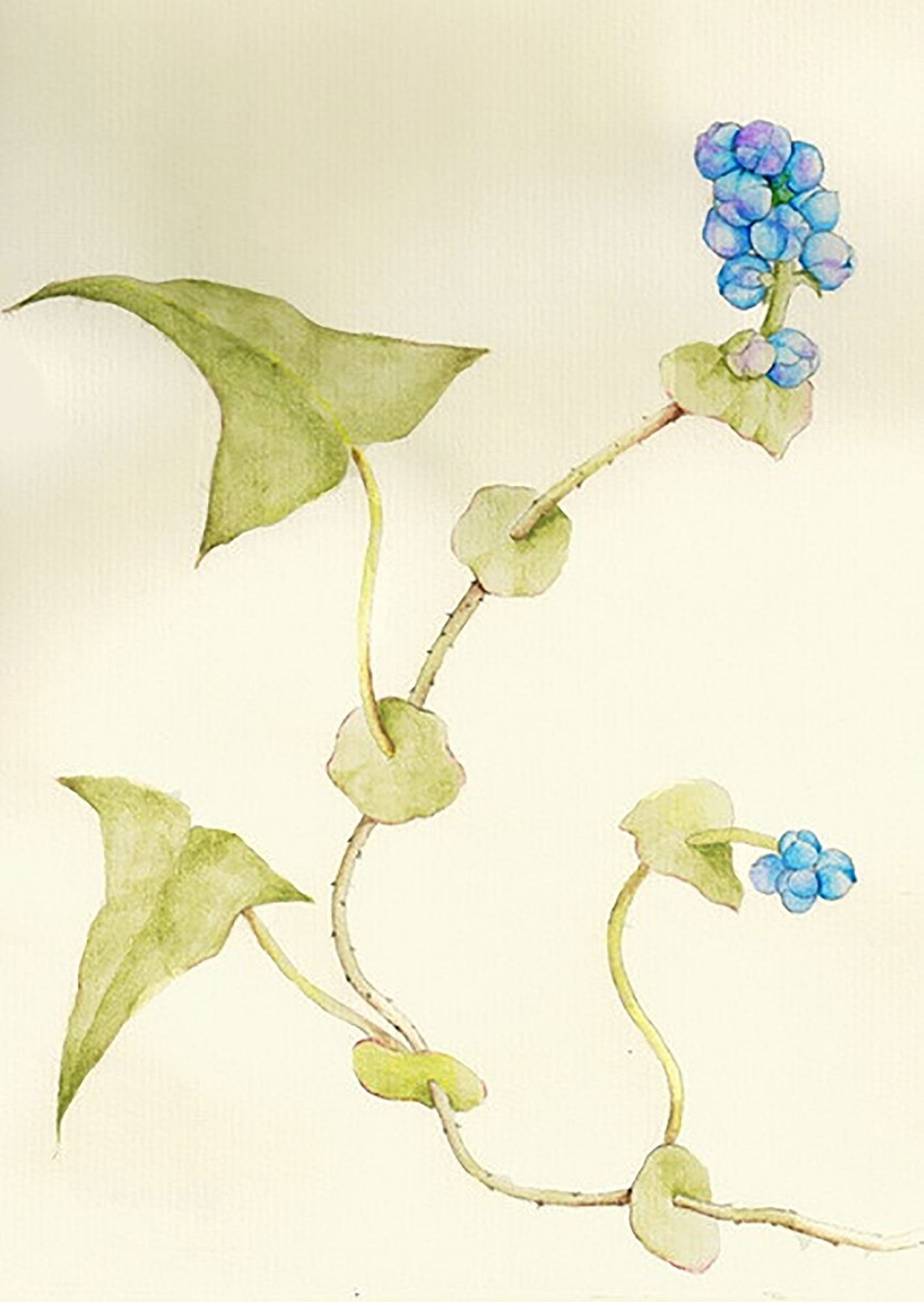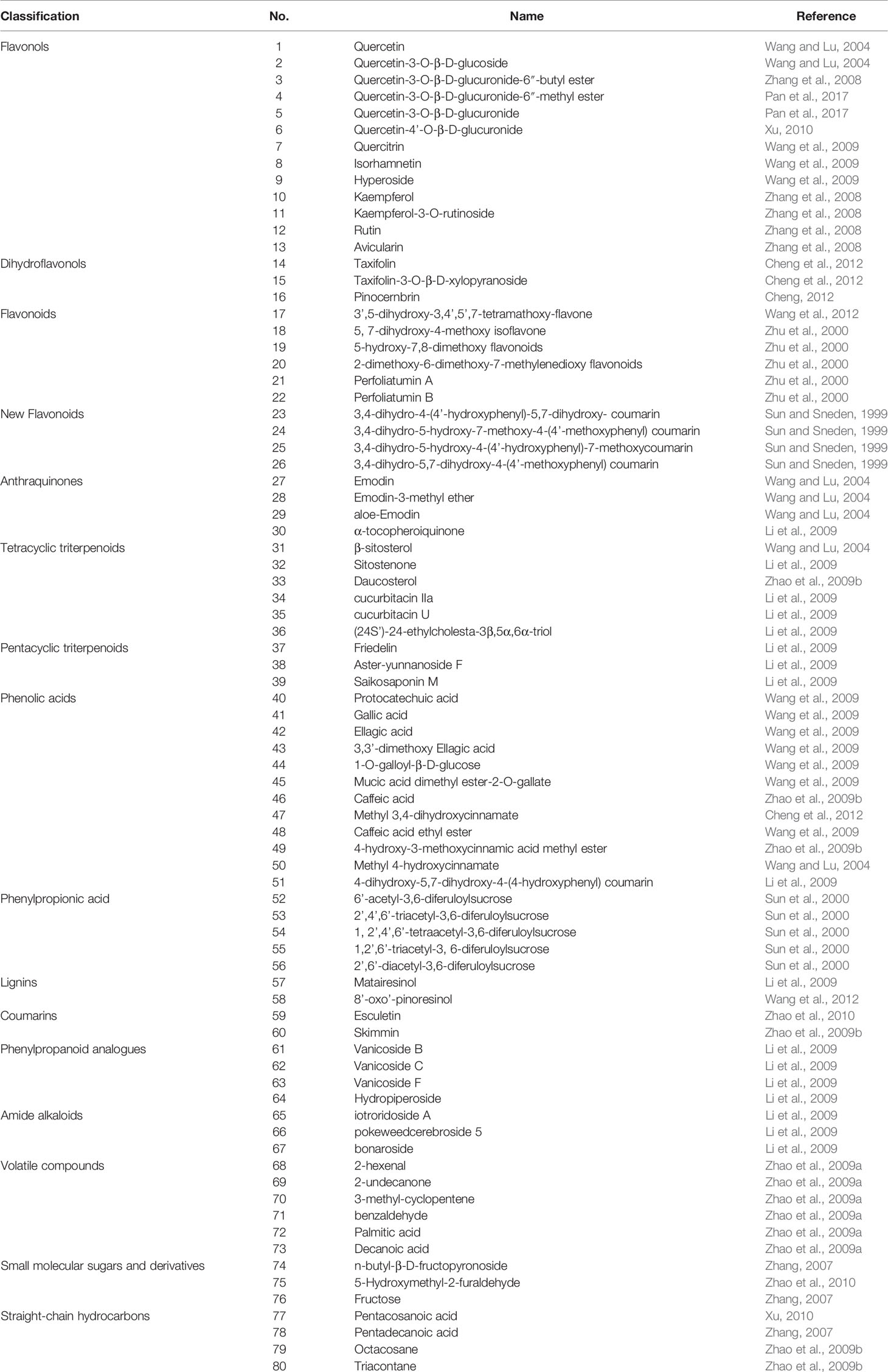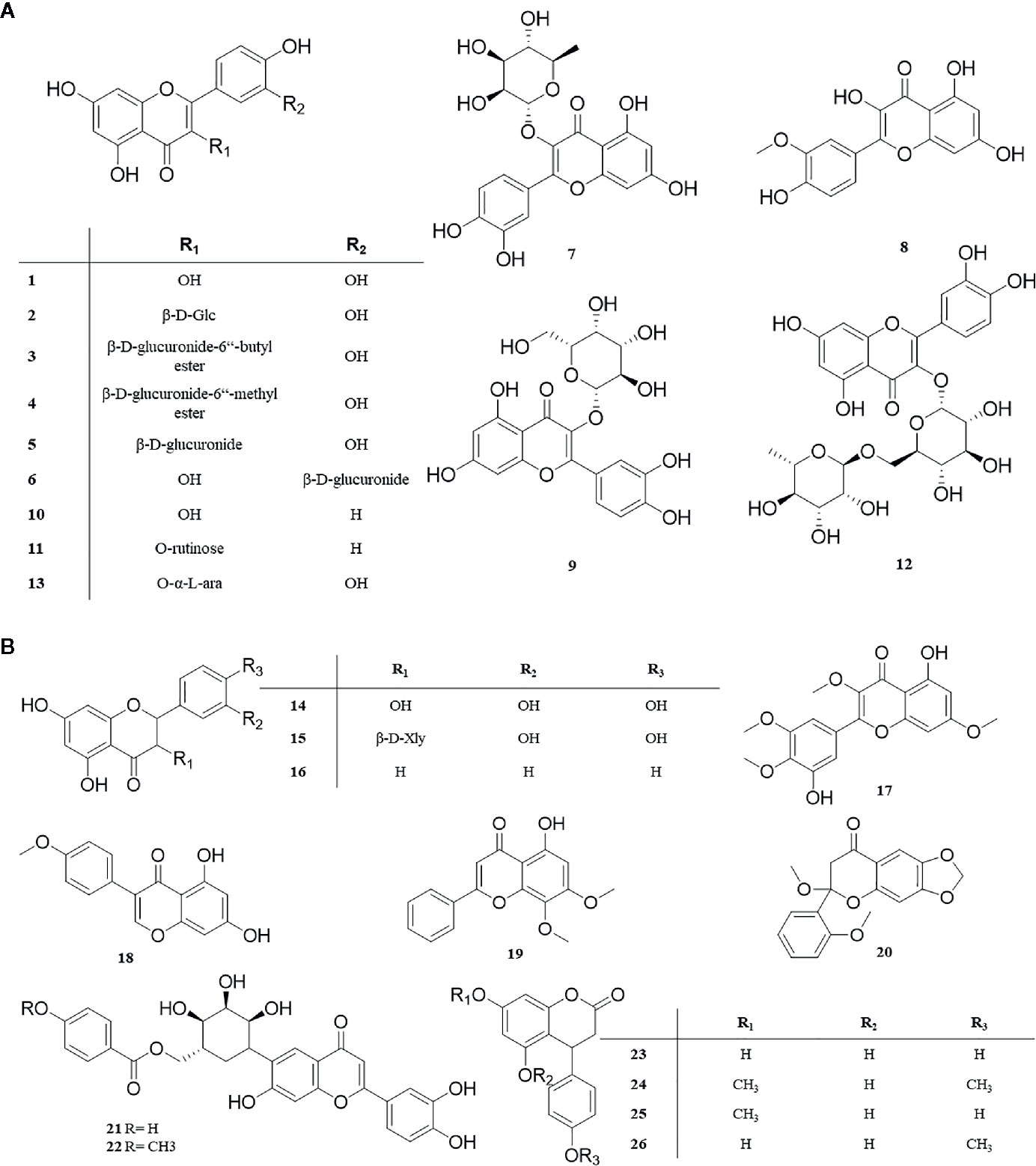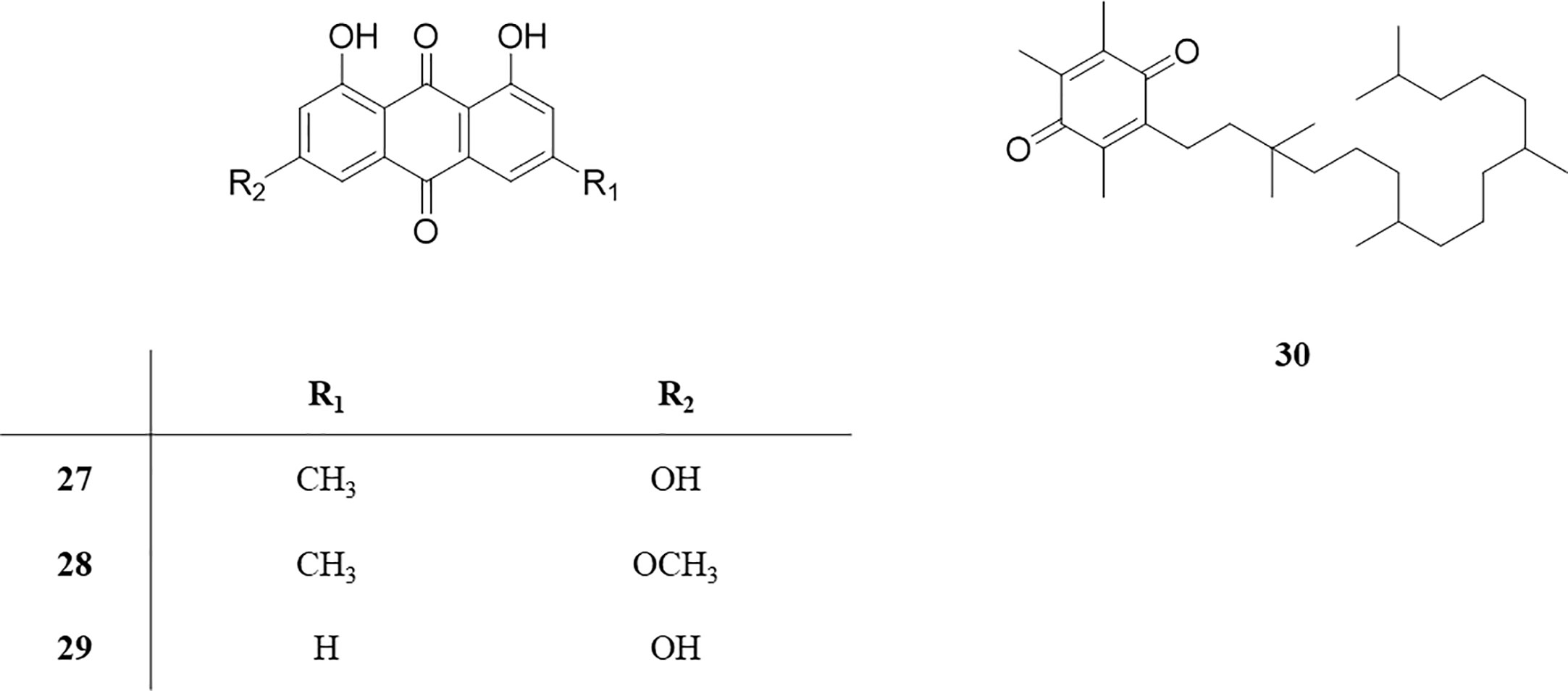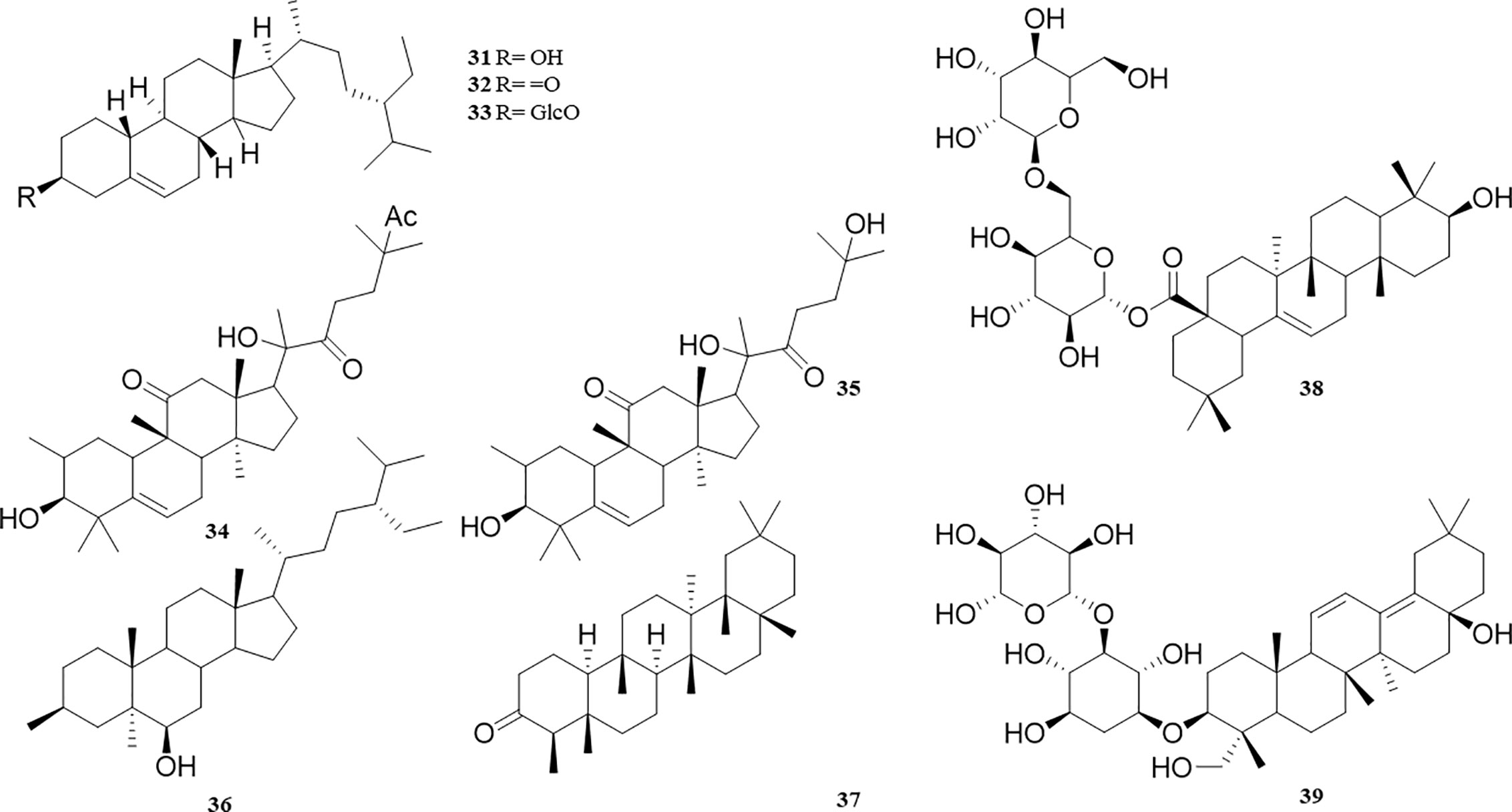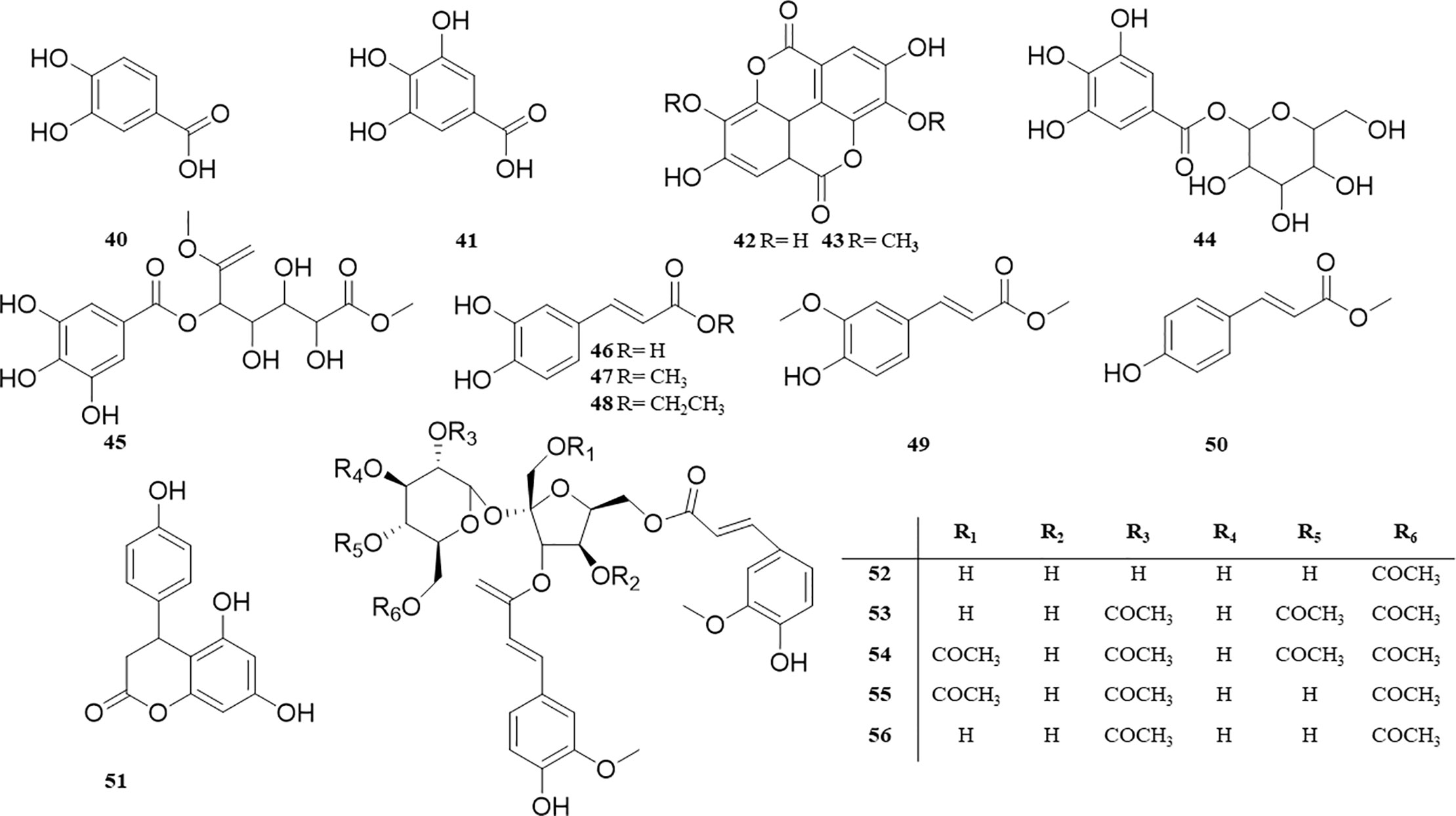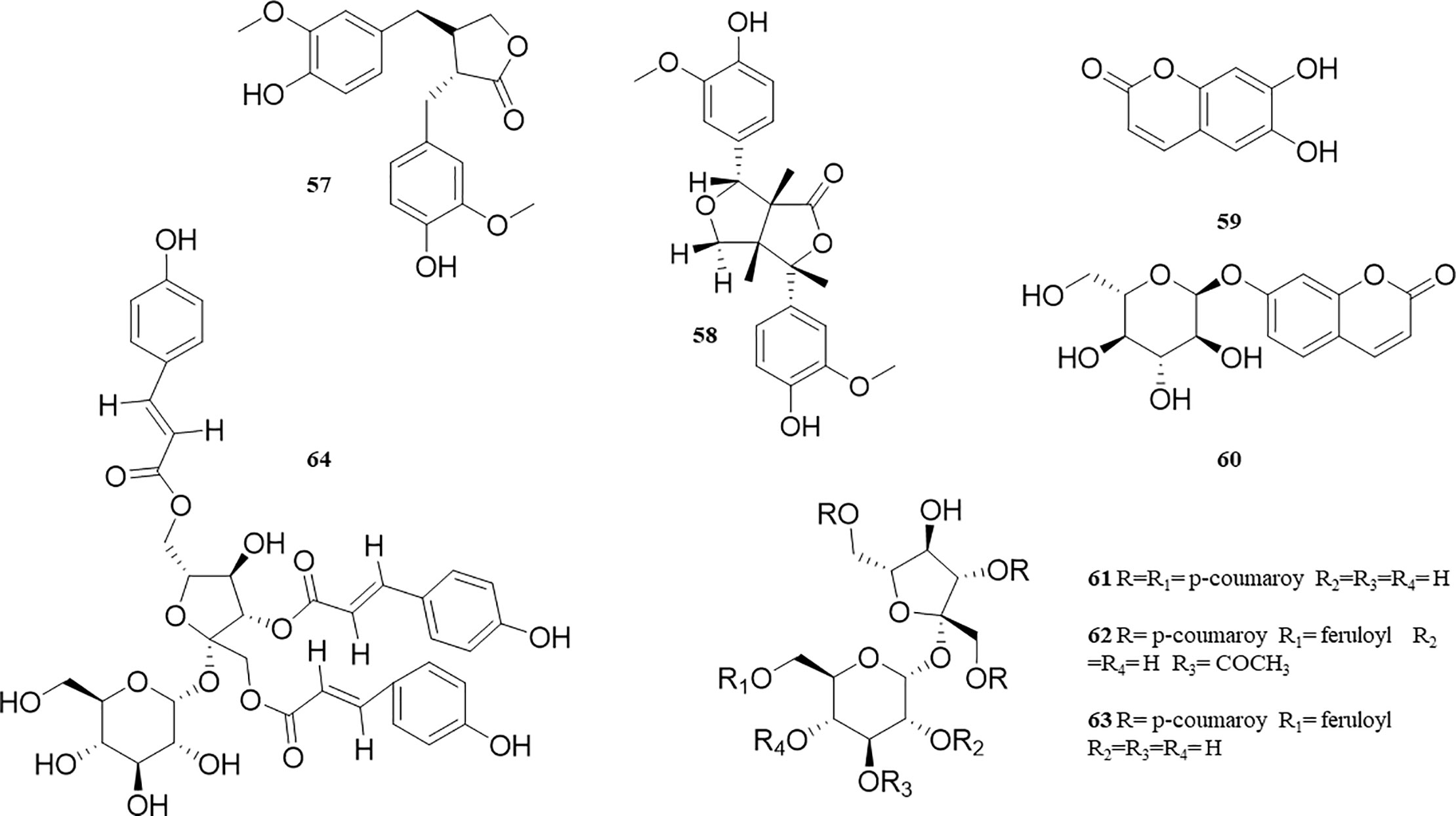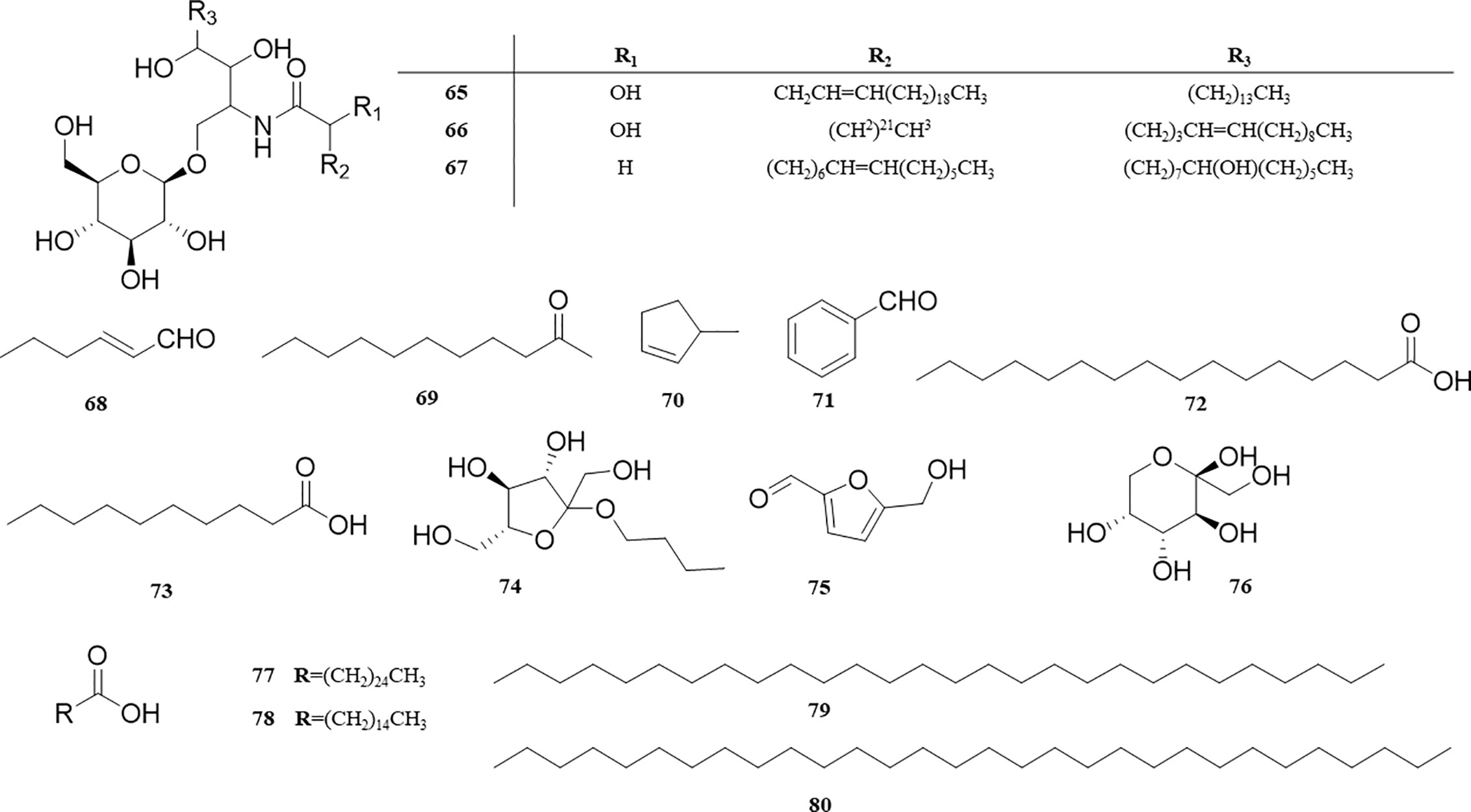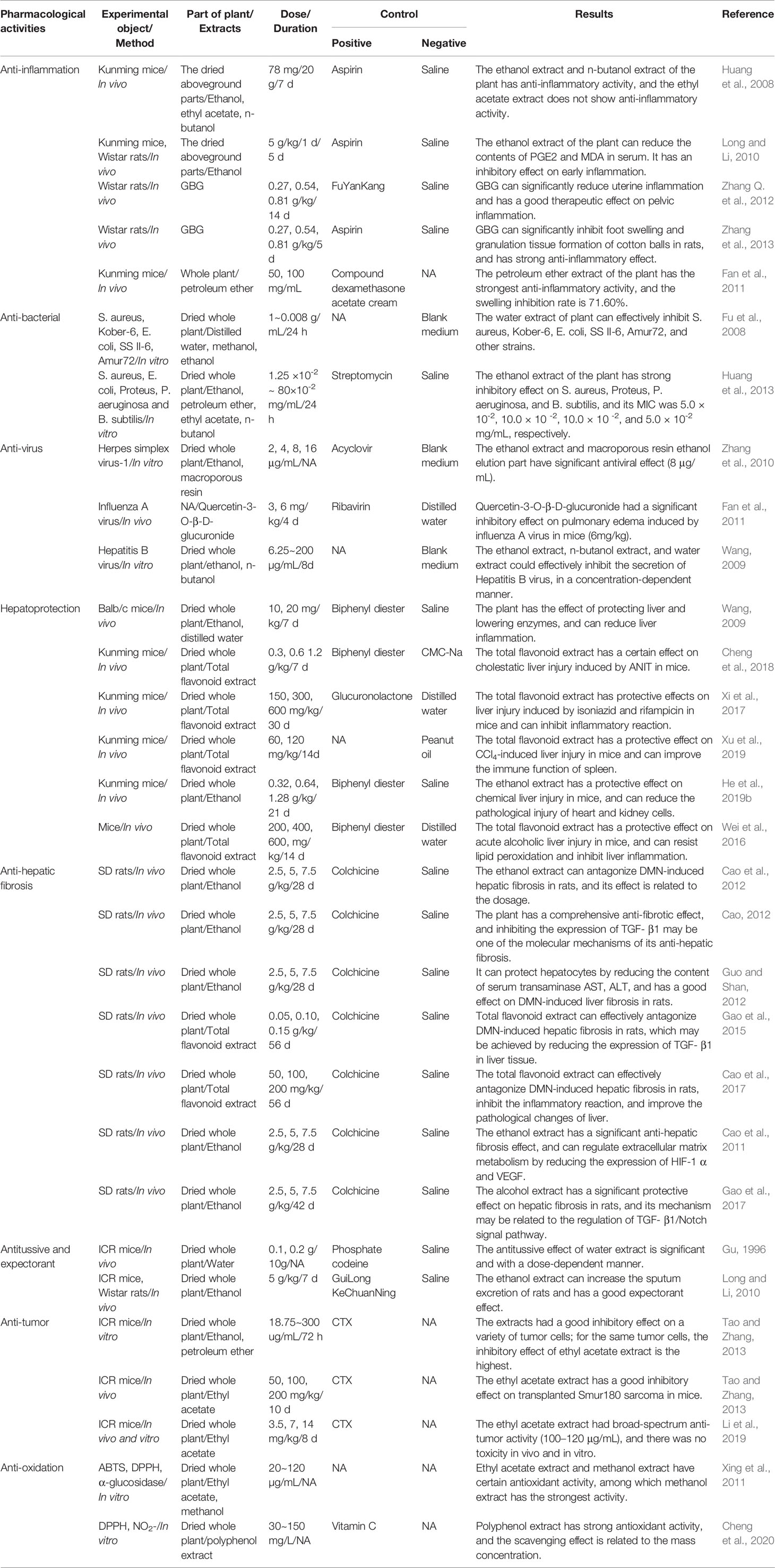- 1College of Pharmacy, Chengdu University of Traditional Chinese Medicine, Chengdu, China
- 2Hospital of Chengdu University of Traditional Chinese Medicine, Chengdu, China
- 3College of Basic Medicine, Chengdu University of Traditional Chinese Medicine, Chengdu, China
Polygonum perfoliatum L. (synonym: Polygonum knotweed L.; Persicaria perfoliata; family: Polygonaceae) is a kind of folk traditional Chinese medicine with a long history of wide use in the treatment of ancient internal, surgical, and gynecological diseases. At present, 80 chemical constituents have been isolated from P. perfoliatum, including flavonoids, anthraquinones, terpenoids, phenolic acids, phenylpropanoids, and alkaloids, among which flavonoids are the main active components. Modern studies have shown that P. perfoliatum has pharmacological activities such as anti-inflammatory, anti-bacterial, antiviral, anti-liver fibrosis, antitussive and expectorant, anti-tumor, anti-oxidation, and so on. By consulting and sorting out a large number of related literatures at home and abroad in recent years, this paper systematically reviewed the botany, traditional uses, phytochemistry, pharmacological activities, and quality control of P. perfoliatum, and discussed its development potential in new drug research and clinical application in the future, in order to provide a reference basis for further research and promote the in-depth development and utilization.
Introduction
P. perfoliatum is a kind of folk traditional Chinese medicine, which has a long history of drug use in China, and its resources are widely distributed in many areas of Asia (Editorial Board of the State Administration of TCM, 1998; Zhao et al., 2006). Before people realized its application values, it was once regarded as a weed and classified as harmful agricultural plants for control (Gao et al., 2013); because of its strong vitality and strong ability to adapt to the environment, it can grow almost anywhere. However, P. perfoliatum integrates food, feeding, and medicine, which can not only be collected and processed into delicious dishes but also as a high-quality livestock and poultry feeding plants. Normal consumption and feeding are beneficial to the health of human beings and animals, and it also has high medicinal value (Ye and Du, 2014). In ancient China, the P. perfoliatum was initially used to treat venomous snake bites. It is said that a person bitten by a poisonous snake was carried to see a doctor on a board, and after using the P. perfoliatum for treatment, he was able to carry the board back home by himself. This is why, in Chinese, P. perfoliatum is named Kang Ban Gui, which means the person who carries the board back. Later, with the accumulation of clinical experience, it has been found that P. perfoliatum can also be used to treat many diseases such as sore throat, lung heat cough, infantile cough, edema and oliguria, damp-heat diarrhea, eczema, furuncles, and so on (State Pharmacopoeia Committee, 2020).
Nowadays, drugs with P. perfoliatum as the main raw material are widely used in the treatment of internal medicine, surgery, and gynecological diseases, and the curative effect is remarkable (Lu, 2011). At present, 80 chemical constituents have been isolated from P. perfoliatum, including flavonoids, anthraquinones, terpenoids, phenolic acids, phenylpropanoids, and alkaloids, showing a wide range of pharmacological activities such as anti-inflammatory, anti-bacterial, antiviral, and so on. Recently, with an increasing interest in the study of the chemical constituents of P. perfoliatum, domestic and overseas researchers have also achieved significant findings in liver diseases, such as hepatoprotective, anti-liver fibrosis, etc.
In this paper, with Polygonum perfoliatum L. as the key word, the botany, traditional uses, phytochemistry, pharmacological activities, and quality control of P. perfoliatum were summarized by searching the relevant literatures in China National Knowledge Infrastructure, Wang Fang, PubMed, Web of Science, and other databases, and discusses the research direction and focus in the future, so as to provide reference for further research, development, and utilization of P. perfoliatum.
Botany
P. perfoliatum is an annual Chinese herbal belonging to the genus Polygonum of Polygonaceae; its stem is bent, much branched, and the whole plant is approximately1‒2 meters in height. The plant is longitudinally angled, with sparse anatropous prickles along ribs. The shape of leaves is triangular, about 3‒7 cm in length and 2‒5 cm in width, its apex is obtuse or apical, and the base is truncate or puberulent, thinly papery, glabrous above, sparsely prickly below along veins. The petiole is nearly as long as leaf blade, with anatropous prickles, peltate inserted near base of leaf blade; the stipule like a sheath, herbaceous, green, with orbicular or suborbicular shape, piercing, 1.5‒3 cm in diameter. Its racemes are like short spike unbranched terminal or axillary, about 1‒3 cm in length; the bracts are ovoid, with 2‒4 flowers in each bract; it has 5 deeply clefted perianth, with white or reddish, perianth segments oval, about 3 mm long, which increase with the fruit and become fleshy and dark blue; there are 8 stamens slightly shorter than perianth; the style is trigeminal, connate in the middle and upper parts. The stigma is capitate, achene globose, 3‒4 mm in diam, black glossy, enclosed in persistent perianth. The florescence is from June to August, and fruiting period is from July to October. The whole plant and its different parts of P. perfoliatum are as shown in Figure 1. P. perfoliatum normally grows in valleys, bushes, fields, or ditches, and it has a strong ability to adapt to survival, but it likes a warm and sunny environment. P. perfoliatum has a wide range of producing areas, not only in China but also in North Korea, Japan, Indonesia, the Philippines, India, Russia (Siberia), and other places (Zhang, 1998; Tan et al., 2013).
Traditional Uses
As a folk traditional Chinese medicine with a long history of use, P. perfoliatum has a variety of effects of food, feeding, and medicine (Ye and Du, 2014), and it is often used as raw food in its tender leaves in the corners of the fields, or its tender stems and leaves are used as dishes; its stems and leaves are also used as feed for pigs, rabbits, geese, and other livestock and poultry; in some rural areas of Guizhou, sun-dried P. perfoliatum is mixed with corn and coarse grains to be used as cheap feed. Some people collect stems and leaves for simple medicinal purposes such as heat-clearing and detoxification, diuresis and detumescence, cough, and so on, and it is widely used in the treatment of sore throat, malaria, lung-heat cough, edema, eczema, diarrhea, hemorrhoids, boils, snakebite, and other diseases (Yang and Yun, 2012).
P. perfoliatum was first recorded in the classic medical book “Wang Bing Hui Chun” in the Ming Dynasty: “To treat snakebites, it is appropriate to use P. perfoliatum, tamping juice, mixing with alcohol, and rubbing the wound with dregs.” Essentials of Medicinal Properties of Raw Herbs (He, 2009) records that it tastes a little bitter, the medicine property is mild, the color of fruit is blue, and it is edible. Textual Research on The Name and Reality Map of Plants (Wu, 1963) records that P. perfoliatum has the function of promoting blood flow and treating gonorrhea. In addition, P. perfoliatum is listed in the quality standard of traditional Chinese medicine in Guizhou Province (Guizhou Medical Products Administration, 2003), and also recorded in many local medical books. According to the Collection of Folk Prescriptions in Guizhou (Yang and Yang, 1978), P. perfoliatum mixed with borneol and sesame oil can be used for the treatment of infectious pustulosis. P. perfoliatum is known to have the ability of diuresis and detumescence, as well as treat joint swelling and pain of the lower extremities (Fujian Medical Research Institute, 1970). Jiangxi Herbal Medicine (Jiangxi Provincial Health Bureau Revolutionary Committee, 1970) recorded that P. perfoliatum stewed with pig large intestine can be used to treat hemorrhoids. P. perfoliatum is also widely used in the treatment of herpes zoster. In ancient times, people called this viral infectious skin disease “waist wrapping fire.” It was named because it often appeared in clusters of erythema blisters on the skin of the waist, showing a banded distribution, and its hurts like being roasted by fire. People collected the P. perfoliatum from the valleys, fields, or ditches, then mashed it and applied it to the affected area, which could effectively relieve the pain of the patient and could be cured in 3‒5 days.
Whole plant of P. perfoliatum can be used as medicine, which has high medicinal value, not only to be eaten but also has a certain health care effect. In the Guangxi Zhuang Autonomous region, people use P. perfoliatum together with other materials to make a tea drink for the treatment of hemorrhoids; its formula has now been patented (Meng, 2017). In addition, P. perfoliatum is also used as the raw material of a health care capsule, which is effective in treating cough and indigestion, strengthening the body, improving immunity, and moisturizing skin tone (Ni, 2018).
Phytochemistry
Although P. perfoliatum has a long history of application, it started relatively late in the study of its chemical constituents. So far, more than 80 compounds have been isolated and identified from P. perfoliatum, including flavonoids (1‒26), anthraquinones (27‒30), terpenoids (31‒39), phenolic acids (40‒51), phenylpropanoids (52‒64), alkaloids (65‒67), and other compounds (68‒80); among them, flavonoids are the most important active components of P. perfoliatum.
Flavonoids
Flavonoids are widely distributed in nature, with anti-tumor, anti-inflammatory, bacteriostatic, liver protection, antioxidant, and other physiological activities (Zhu et al., 2016), and it’s also a kind of chemical constituent that has been widely reported in P. perfoliatum related literature. At present, 26 flavonoids (1‒26) have been isolated from P. perfoliatum, including 13 flavonols (1‒13), Quercetin (1), Quercetin-3-O-β-D-glucoside (2), Quercetin-3-O-β-D-glucuronide-6″-butyl ester (3), Quercetin-3-O-β-D-glucuronide-6″-methyl ester (4), Quercetin-3-O-β-D-glucuronide (5), Quercetin-4’-O-β-D-glucuronide (6), Quercitrin (7), Isorhamnetin (8), Hyperoside (9), Kaempferol (10), Kaempferol-3-O-rutinoside (11), Rutin (12), and Avicularin (13).
Cheng et al. (2012) isolated three dihydroflavonols (14‒16) from the ethyl acetate extract of P. perfoliatum: Taxifolin (14), Taxifolin-3-O-β-D-xylopyranoside (15), and Pinocernbrin (16). Six flavonoids (17‒22) were discovered from P. perfoliatum: 3’,5-dihydroxy-3,4’,5’,7-tetramathoxy-flavone (17), 5, 7-dihydroxy-4-methoxy isoflavone (18), 5-hydroxy-7,8-dimethoxy flavonoids (19), 2-dimethoxy-6-dimethoxy-7-methylenedioxy flavonoids (20), Perfoliatumin A (21), and Perfoliatumin B (22). Four new flavonoids (23‒26) were reported for the first time (Sun and Sneden, 1999): 3,4-dihydro-4-(4’-hydroxyphenyl)-5,7-dihydroxy- coumarin (23), 3,4-dihydro-5-hydroxy-7-methoxy-4-(4’-methoxyphenyl) coumarin (24), 3,4-dihydro-5-hydroxy-4-(4’-hydroxyphenyl)-7-methoxycoumarin (25), and 3,4-dihydro-5,7-dihydroxy-4-(4’-methoxyphenyl) coumarin (26). These compounds and their corresponding structures are shown in Table 1 and Figures 2A, B.
Anthraquinones
Anthraquinones are abundant in polygonaceae plants, which have many pharmacological effects, such as anti-virus, anti-tumor, liver protection, blood lipid lowering, blood pressure lowering, antibacterial, anti-inflammatory, and so on. Four anthraquinones, emodin (27), emodin-3-methyl ether (28), aloe-emodin (29), and α-tocopheroIquinone (30), were isolated from the roots of P. perfoliatum for the first time in 2004 (Wang and Lu, 2004); after that, no new compounds were reported. These anthraquinones and their corresponding structures are shown in Table 1 and Figure 3.
Terpenoids
Terpenoids in P. perfoliatum are rarely reported. At present, 9 terpenoids have been isolated from P. perfoliatum, including 6 tetracyclic triterpenoids with basic structure of cyclopentano polyhydrophenanthrene (31‒36), β-sitosterol (31), Sitostenone (32), Daucosterol (33), cucurbitacin IIa (34), cucurbitacin U (35), and (24S’)-24-ethylcholesta-3β,5α,6α-triol (36). The other 3 compounds are pentacyclic triterpenoids (37‒39), including Friedelin (37), Aster-yunnanoside F (38), and Saikosaponin M (39). These compounds and their corresponding structures are shown in Table 1 and Figure 4.
Phenolic Acids
The chemical constituents of phenolic acids in P. perfoliatum are polar, and the active components are mainly enriched in n-butanol and water extracts. It has been found that phenolic acids have anti-inflammatory and antiviral activities, which may be related to the Gallic acyl groups in the structure. At present, 12 compounds of phenolic acids have been isolated from P. perfoliatum (40‒51). Wang et al. (2009) reported 7 compounds: Protocatechuic acid (40), Gallic acid (41), Ellagic acid (42), 3,3’-dimethoxy Ellagic acid (43), 1-O-galloyl-β-D-glucose (44), Mucic acid dimethyl ester-2-O-gallate (45), and Caffeic acid ethyl ester (48). The other 5 compounds are Caffeic acid (46), Methyl 3,4-dihydroxycinnamate (47), 4-hydroxy-3-methoxycinnamic acid methyl ester (49), Methyl 4-hydroxycinnamate (50), and 4-dihydroxy-5,7-dihydroxy-4-(4-hydroxyphenyl) coumarin (51).These compounds and their corresponding structures are shown in Table 1 and Figure 5.
Phenylpropanoids
Thirteen phenylpropanoids (52‒64) were proven to exist in P. perfoliatum. Five phenylpropionic acid compounds include 6’-acetyl-3,6-diferuloylsucrose (52), 2’,4’,6’-triacetyl-3,6-diferuloylsucrose (53), 1,2’,4’,6’-tetraacetyl-3,6-diferuloylsucrose (54), 1,2’,6’-triacetyl-3, 6-diferuloylsucrose (55), and 2’,6’-diacetyl-3,6-diferuloylsucrose (56). There are 2 lignins isolated from P. perfoliatum: 7,7’-dihydroxymatairesinol (57) and 8’-oxo’-pinoresinol (58). Esculetin (59) and Skimmin (60), two coumarins, were separated from P. perfoliatum. Li et al. (2009) separated 4 phenylpropanoid analogues: Vanicoside B (61), Vanicoside C (62), Vanicoside F (63), and Hydropiperoside (64). These compounds and their corresponding structures are shown in Table 1 and Figure 6.
Alkaloids and Other Compounds
Amide alkaloids (65‒67), volatile components (68‒73), and other components (74‒80) were also isolated from P. perfoliatum. Amide alkaloids, such as IotroridosideA (65), pokeweedcerebroside 5 (66), and bonaroside (67), were isolated from P. perfoliatum for the first time (Li et al., 2009). Zhao et al. (2009a) obtained volatile components such as 2-hexenal (68), 2-undecanone (69), 3-methyl-cyclopentene (70), benzaldehyde (71), palmitic acid (72), and decanoic acid (73) from P. perfoliatum by solid phase microextraction (SPME). In addition, P. perfoliatum also contains some small molecular sugars and straight-chain hydrocarbons: n-butyl-β-D-fructopyronoside (74), 5-Hydroxymethyl-2-furaldehyde (75), Fructose (76), Pentacosanoic acid (77), Pentadecanoic acid (78), Octacosane (79), and Triacontane (80). These compounds and their corresponding structures are shown in Table 1 and Figure 7.
Pharmacological Activities
Modern pharmaceutical studies have shown that different extracts of P. perfoliatum have anti-inflammatory, bacteriostatic, anti-viral, anti-liver fibrosis, antitussive and expectorant, anti-tumor, and other pharmacological activities (Table 2). Clinically, it is widely used in the treatment of a variety of viral infectious skin diseases and gynecological inflammatory diseases, such as herpes zoster, eczema, and pelvic inflammation. However, most of the published studies lack information about the identification of their active compounds, their action mechanisms and targets in vivo, and related extract preparations, which need to be further explored and studied.
Anti-Inflammatory
It was found that the ethanol extract had a significant inhibitory effect on xylene-induced auricle swelling in mice, with an inhibition rate of 81.67%, while that of aspirin, a positive control drug, was only 61.83%. The swelling inhibition rates of ethyl acetate and n-butanol isolated part from the P. perfoliatum ethanol extract on mouse auricle were 22.39% and 41.47%, respectively, suggesting that the anti-inflammatory active components were lost or not effectively separated in the separation process of ethanol extract, and the separation and extraction process needs to be further optimized (Huang et al., 2008). The Long (Long and Li, 2010) study found that the ethanol extract could significantly inhibit the increase of abdominal capillary permeability induced by acetic acid in mice, and reduce the absorbance (OD value) of mouse peritoneal saline washing solution at 590 nm. In addition, ethanol extract could significantly reduce the contents of PGE2 and MDA in serum and inflammatory tissue of rats with toe swelling induced by carrageenan. It is suggested that the anti-inflammatory mechanism of P. perfoliatum may be related to the decrease of the content of PGE2 in inflammatory tissue and the inhibition of lipid peroxidation.
In the study of Zhang Q. et al. (2012), it was found that a drug with P. perfoliatum as the main component, named GBG, was effective in the treatment of pelvic inflammation in rats caused by plastic tube insertion into the uterus, reducing endometrial congestion and edema, reducing the rate of uterine swelling, and improving pathological damage such as uterine adhesion occlusion, epithelial cell degeneration, and necrosis and inflammatory cell infiltration. In addition, GBG can also significantly inhibit the local tissue swelling of mice caused by a variety of inflammatory substances and the formation of granulation tissue in rats, and reduce the inflammatory response in a dose-dependent manner (Zhang et al., 2013).
In the HPLC chromatogram obtained from anti-inflammatory extracts of P. perfoliatum, the researcher found that the peak of quercetin-3-O-β-D-glucuronide is the highest. Moreover, it was found that quercetin-3-O-β-D-glucuronide could inhibit lipid peroxidation (Shirai et al., 2001; Begum and Terao, 2002), angiotensin II-stimulated JNK activation (Kyaw et al., 2004), and the production of reactive oxygen species (ROS) (Shirai et al., 2006). The content of quercetin-3-O-β-D-glucuronide was 0.90%, which was higher than that of quercetin in P. perfoliatum, indicating that the quercetin-3-O-β-D-glucuronide was one of the major active compounds of P. perfoliatum, and it is closely related to the anti-inflammatory effect.
Anti-Bacterial
The water extract of P. perfoliatum has certain inhibitory effect on Staphylococcus aureus, Pasteurella multocida, Streptococcus, Salmonella, and Escherichia coli in vitro, and the minimum inhibitory concentration (MIC) is 0.031 g/mL, 0.25 g/mL,0.063 g/mL, 0.125 g/mL, and 0.063 g/mL, respectively (Fu et al., 2008). After further study, it was found that the bacteriostatic effect of P. perfoliatum organic solvent extract was better than that of water extract; through the study on the antibacterial activity of petroleum ether extract, ethyl acetate extract, and n-butanol extract of the P. perfoliatum ethanol extract, it was found that ethyl acetate had the strongest antibacterial activity and had significant bacteriostatic effect on Staphylococcus aureus, Escherichia coli, Streptococcus faecalis, and other pathogens (Huang et al., 2008). N-butanol extract can inhibit Bacillus subtilis and Pseudomonas aeruginosa, and while petroleum ether has no inhibitory effect on the above bacteria (Huang et al., 2013), this may be related to the fact that most of the petroleum ether extracts contain chlorophyll, tannins, and other components, but most of these components have no pharmacological activity. In addition, from the prominent anti-bacterial activity of ethyl acetate and n-butanol extract, it can be inferred that the anti-bacterial components of P. perfoliatum have greater polarity and may be dominated by flavonoids. The bacteriostatic experimental studies on P. perfoliatum are all in vitro, and only the anti-bacterial activity of the crude extract was evaluated, but it is not clear which compound is the main anti-bacterial component. The bacteriostatic experiment of P. perfoliatum in vivo has not been reported.
Anti-Viral
For a long time, P. perfoliatum has been widely used to treat diseases caused by viral infections such as herpes zoster (Xu et al., 2017). Modern pharmacological studies have found that ethanol extract, water extract, and n-butanol extract of P. perfoliatum have good antiviral activity, and it is found that the main active constituents are flavonoids and water-soluble phenolic acids. Zhang et al. (2010) tested the effect of P. perfoliatum extract against herpes simplex virus-1 (HSV-1) in vitro by MTT, and it was found that its ethanol extract and ethanol elution part of D101 macroporous resin had significant antiviral effect, which was similar to positive control drug acyclovir (ACV), and the virus inhibition rates were 78.10%, 75.2%, and 81.6%, respectively; taking rutin as the standard reference substance, the content of active extract was determined by aluminum nitrate complexation spectrophotometry, and the results showed that the content of flavonoids was more than 80%. Through further experimental studies, it was found that the flavonoids of P. perfoliatum had a strong inhibitory effect on the replication and intercellular transmission of HSV-1 virus (Fan et al., 2011), and could significantly prolong the survival time and improve the survival rate of mice with encephalitis induced by HSV-1 infection (Zhang et al., 2014). It is an effective method for the treatment of recurrent HSV-1 infection. However, it remains to be further studied on how the active components enter the cell and through what mechanism to block the virus infection and inhibit the replication of the virus.
The appropriate dose of P. perfoliatum water extract can effectively fight influenza virus and reduce lung inflammation, and it shows good antiviral effect by reducing the content of serum inflammatory factors TNF-α and IL-1, increasing the level of antibody IgA, IgG, IgG1b, and IgG2a, reducing lung index, and relieving lung inflammation in influenza mice (Wang et al., 2017); the mechanism is mainly through humoral immune response, and the antibodies in the serum can effectively neutralize the virus, activate the cascade of complements, and limit the replication and spread of pathogens (Lai et al., 2015). Quercetin-3-O-β-D-glucuronide, a flavonoid in P. perfoliatum, could significantly inhibit pulmonary edema induced by influenza A virus in mice, but the exact mechanism of action is not clear; the experimental results show that when the dose of quercetin-3-O-β-D-glucuronide is 6mg/ml, the inhibitory effect is stronger than that of the positive control drug ribavirin.
Wang (2009) reported that the water-soluble phenolic acids in PEE are the main active substances against hepatitis B virus (HBV), which can significantly inhibit the secretion of antigen (HBeAg) by HepG22.2.15 cells. The inhibition rate at non-toxic concentration can reach 74.02 ±11.43%, and the treatment index TI > 2.0, which is a low-toxic and efficient drug. Most of the anti-HBV active constituents are concentrated in n-butanol and water parts and contain common structural unit Gallic acyl groups. The more the number of Gallic acyl groups in the structure, the stronger the anti-HBV activity.
Hepatoprotection and Anti-Liver Fibrosis
The liver is the main metabolic organ of the human body, and many factors, such as chemical drugs, pathogenic microorganisms, alcohol, and so on, can induce liver injury and cause liver cirrhosis, liver fibrosis, liver cancer, and other diseases (Xin and Qing, 2018). P. perfoliatum ethanol extract and total flavonoid extract have excellent hepatoprotective activity (He et al., 2019a). The ethanol extract of P. perfoliatum has a certain protective effect on acute immune liver injury induced by ConA in mice, and can effectively reduce the liver injury caused by concomitant inflammation. The mechanism may be related to the regulation of Kupffer cell function and reducing the synthesis and release of inflammatory mediator TNF- α (Wang, 2009). Total flavonoid extract of P. perfoliatum can reduce the activities of ALT, AST, TBA, TBIL, and LDH in serum, increase the activities of SOD and GSH in liver, reduce the content of lipid peroxide MDA, and it is suggested that the total flavonoids of P. perfoliatum can protect hepatocytes by inhibiting oxidative free radicals and improving the ability of antioxidation, and inhibit the lipid peroxidation induced by α-naphthalene isothiocyanate (ANIT) by reducing the content of lipid peroxidation product MDA in liver tissue (Cheng et al., 2018). In the study of the protective effect of P. perfoliatum on drug-induced liver injury induced by isoniazid and rifampicin in mice, it was found that under the intervention of total flavonoids of P. perfoliatum, the levels of TNF- α, IL-1β, and IL-6 in liver tissue of mice decreased, and the expression of Fas was significantly decreased by Western blotting assay, which had significant anti-drug-induced liver injury. The mechanism may be related to blocking Fas-mediated apoptosis pathway and inhibiting inflammatory response (Xi et al., 2017). The study of Xu et al. (2019) found that the extract of total flavonoids of P. perfoliatum could reduce the content of Hsp90, TNF- α, and IL-6 in the cells of mice with liver injury induced by carbon tetrachloride, increase the number of integrin β1, 5’- nucleotidase and positive antigen KI-67 cells in spleen, and reduce the pathological injury of liver; the mechanism may be through the inhibition of inflammatory stress reaction and apoptosis, inactivate Hsp90 in hepatocytes, and improve spleen immunity to protect liver. Total flavonoids of P. perfoliatum also have protective effects on acute alcoholic liver injury. It can improve antioxidation by scavenging lipid peroxides, reduce the content of inflammatory factors IL-4, IL-6, and TNF- α, and inhibit liver inflammation, while improving the immune capacity of the damaged body (Wei et al., 2016). In addition, the ethanol extract of P. perfoliatum not only alleviated the liver injury induced by carbon tetrachloride but also improved the structural damage of cardiomyocytes and glomeruli (He et al., 2019b).
In addition to the hepatoprotective effect, the total flavonoid extract of P. perfoliatum also showed significant anti-fibrosis activity (Cao, 2012) and had a good antagonistic effect on rat liver fibrosis induced by DMN (Cao et al., 2012; Guo and Shan, 2012). After the intervention of P. perfoliatum total flavonoid extract, the contents of serum HA, LN, PC III, IV-C, and other pathological indexes of liver fibrosis decreased, the degree of proliferation of hoof tissue in liver tissue decreased, the distribution of collagen decreased, and the degree of inflammation and fibrosis of liver tissue were greatly improved (Zhang et al., 2012); the mechanism is related to the fact that the flavonoid extract of P. perfoliatum can inhibit the expression of TGF- β1, prevent the activation of HSC into fibroblasts, inhibit the synthesis of extracellular matrix ECM, and promote its degradation (Gao et al., 2015).
In recent years, through the further study on the hepatoprotective mechanism of the total flavonoid extract of P. perfoliatum, Cao et al. (2017) have found that phosphorylated JAK2/STAT3 signal pathway can induce the expression of inflammatory cytokines in the process of liver fibrosis, and continuously secrete extracellular matrix ECM through positive feedback regulation of continuous activation of HSC; P. perfoliatum flavonoids can down-regulate the expression of α-SMA, TGF- β1, IL-1β, and IL-6, inhibit the activation of JAK2/STAT3 signal pathway, and improve liver pathological changes. In addition, the abnormal expression of TGF-β1 and JAK2/STAT3 pathway is consistent, and the relationship of mutual regulation between them has not been reported, which is worthy of further exploration. Gao et al.’s (2017) study found that P. perfoliatum flavonoids can significantly decrease the contents of TGF-β1, Notch-1, and α-SMA in liver tissue of rats with DMN-induced hepatic fibrosis, increased the expression of E-cadherin protein, inhibited the process of epithelial stroma transformation, and then reduced the secretion of extracellular matrix, preventing excessive deposition of fibrous hoof tissue. The mechanism is related to the regulation of TGF-β1/Notch signal pathway; some studies have shown that Notch-1 in Notch pathway is the effector gene of TGF- β1, and the flavonoids of P. perfoliatum may inhibit the EMT process induced by TGF-β 1 by blocking Notch signal pathway, so as to exert its anti-fibrosis effect.
Antitussive and Expectorant
The syrup and decoction made of P. perfoliatum are clinically used in the treatment of pertussis, and the curative effect is remarkable (Zhan, 1996). It was found that the P. perfoliatum water extract inhibited the cough of ammonia-induced cough mice in a dose-dependent manner. The high dose group (0.2g/10g) significantly promoted the excretion of phenol red in the respiratory tract of mice in the phenol red expectorant experiment, and this shows that the higher dose of P. perfoliatum water extract has expectorant effect (Gu, 1996). Long and Li (2010) used SO2 to induce cough in mice and found that P. perfoliatum could prolong the cough latency of mice induced by SO2 stimulation, reduce the number of coughs, relieve cough significantly, and increase the sputum excretion of Wistar rats after drug modeling. Zhang et al. (2016) found that P. perfoliatum with honey can effectively prolong the latency of cough induced by concentrated ammonia water in mice, reduce the number of cough in mice, and the antitussive effect is stronger than crude plant.
Anti-Tumor
The ethyl acetate extract from P. perfoliatum has a good inhibitory effect on tumor proliferation in vivo and in vitro (Tao and Zhang, 2013), and it can strongly inhibit the growth and proliferation of human gastric cancer SGC-7901 cells, colon cancer Colo320 cells, prostate cancer PC-3 cells, and acute myeloid leukemia HL60 cells in vitro (IC50 < 50ug/mL), but has a weak inhibitory effect on mouse melanoma B-16 cells (IC50 ≥ 91.63ug/mL). In vivo, the inhibition rate of P. perfoliatum ethyl acetate extract high dose group (200 mg/kg) on implanted sarcoma (S-180) in mice was 58.46%, and the inhibition rate of cyclophosphamide (CTX) in the positive control group was 52.31%.
Li et al. (2019) obtained an anti-tumor active component named PEC, through the separation of ethyl acetate extract from P. perfoliatum, and found that flavonoids were the main active components of PEC. PEC can effectively inhibit the proliferation of human cervical cancer cells, gastric cancer cells, prostate cancer cells, lung cancer cells, glioma cells, and pancreatic cancer cells in vitro. It also has obvious inhibitory effect on mouse hepatoma cell and sarcoma cell in vivo, and its inhibitory effect was dose-dependent. In addition, PEC can reduce the expression of VEGF in tumor tissue, reduce the density of microvascular system in tumor tissue, increase the activity of NK cells and cytotoxic lymphocytes (CTL), promote the proliferation of T lymphocytes and B lymphocytes, increase the activity of T lymphocytes, enhance the secretion of splenocyte IL-2, and raise the levels of IgG, IgG2a, and IgG2b in serum. It is suggested that its anti-tumor mechanism may be to inhibit the proliferation of tumor cells by improving immune ability, promoting tumor vascular necrosis, or hijacking tumor cells stagnated in G2 phase.
Anti-Oxidation
The ethyl acetate and methanol extract isolated from P. perfoliatum can scavenge ABTS and DPPH free radicals in a dose-dependent manner. Cheng et al. (2020) obtained the polyphenol extract from P. perfoliatum by ultrasonic combined with Tween 80 extraction method, and found that it had strong antioxidant activity, at the same concentration, the scavenging rate and total reduction ability of polyphenol extract to DPPH free radicals was stronger than positive control drug Vitamin C, and the scavenging effect was positively correlated with the mass concentration. In addition, the extract of petroleum ether, ethyl acetate, and methanol from P. perfoliatum also had inhibitory effect on α-glucosidase activity (Xing et al., 2011), among which methanol extract had the strongest inhibitory activity, and the IC50 was 16.14 mg/L, which was much lower than positive control group (1081.27 mg/L).
Quality Control
The current edition of the Pharmacopoeia of the People’s Republic of China (2020 edition) uses thin layer chromatography to qualitatively identify caffeic acid and high performance liquid chromatography (HPLC) to determine the content of quercetin, which is used to control the quality of P. perfoliatum; however, caffeic acid and quercetin exist widely in plants and their specificity is not strong, so it is necessary to use advanced technology and analytical methods to establish a scientific and reasonable quality evaluation system to provide a basis for the production and quality control of P. perfoliatum.
At present, the determination of index components in P. perfoliatum is still mostly determined by HPLC, but it is not limited to the determination of a single component, and multi-component determination has gradually become a hot spot. Cheng et al. (2013) used HPLC to determine quercetin and kaempferol in P. perfoliatum; Tong (2011) used HPLC to determine oleanolic acid and ursolic acid. Huang Jiayu used HPLC to determine ferulic acid and vanillic acid. Li et al. (2011) and Xu et al. (2009) determined the content of quercetin in different parts of P. perfoliatum by HPLC. Mao et al. (2010) determined the content of chlorogenic acid in P. perfoliatum by HPLC. Fan et al. (2014) established a HPLC for the simultaneous determination of esculetin, quercetin, quercetin-3-O-β-D-glucuronide, and quercetin-3-O-β-D-glucuronide-6″-methyl ester. Liu et al. (2010) determined the content of quercetin in stems and leaves of P. perfoliatum in different harvest periods by HPLC, it was found that the content of quercetin in leaves was significantly higher than that in stems, and August is the best harvest season. In addition, some advanced analytical techniques and determination methods have been gradually applied to the quality control of P. perfoliatum. Li et al. (2012) separated and determined ferulic acid, caffeic acid, and protocatechuic acid in P. perfoliatum by sweeping-MEKC. Jin et al. (2009) simultaneously determined quercetin, vanillic acid, ferulic acid, caffeic acid, and protocatechuic acid in P. perfoliatum by Electrophoretic-electrochemical method (CE-ED).
In recent years, fingerprint has been widely used in the quality control of traditional Chinese medicine. Tian et al. (2013) tested the 51 batches of P. perfoliatum samples collected from different locations or in different harvesting times in China by establishing the HPLC fingerprint determination method of P. perfoliatum, than analyzed the fingerprint obtained by chemometrics, similarity analysis, cluster analysis, and principal component analysis. Finally, the characteristic map is obtained. On the basis of the above, the pharmacodynamic similarities and differences of different batches of P. perfoliatum with statistical differences were analyzed. Finally, the researchers used mathematical statistical methods such as grey correlation degree method to statistically analyze the chemical information characterized by the chromatographic peaks of the chemical fingerprints of different batches of P. perfoliatum and the biological information characterized by the results of pharmacodynamics. Look for chemical substances that are closely related to pharmacodynamics. These studies have laid a good foundation for the identification of active components and quality control of P. perfoliatum.
Conclusion and Prospect
P. perfoliatum is a kind of folk traditional Chinese medicine, which has a long history and definite curative effect in China. It is clinically effective in the treatment of herpes zoster, pertussis, acute bacillary dysentery, and gynecological inflammation. However, the research on P. perfoliatum is not comprehensive and in-depth in many aspects, and this paper discusses the research direction and focus of P. perfoliatum in the future from the following aspects:
① At present, 80 chemical constituents have been isolated from P. perfoliatum. Among them, flavonoids are the main active constituents, accounting for 32.5% of the isolated chemical constituents. The existing studies on the chemical constituents of P. perfoliatum are mostly focused on flavonoids, while the studies on other chemical constituents are less. For example, although the content of phenolic acids is much less than that of flavonoids, it still shows significant pharmacological activity, and according to the results of previous studies, phenolic acids may be the material basis of anti-inflammatory and antiviral effects. In addition, as the most important and abundant active components in P. perfoliatum, the research on flavonoids is not deep enough; study on the basic substances of pharmacology is still in the crude extract stage, and the specific active compounds have not been isolated and identified, which makes it difficult to establish the relationship between the chemical constituents and pharmacological activities, thus affecting further research in all aspects. Therefore, in the future, we should strengthen the basic research on the chemical constituents and pharmacological activities of P. perfoliatum.
② In recent years, the research found that P. perfoliatum total flavonoid extract has a good protective effect on liver tissue injury, and can improve and repair the damaged liver tissue structure, showing a good prospect of development and application in hepatoprotective and anti-hepatic fibrosis. However, many studies have reported that the pharmacological mechanisms of hepatoprotection and anti-hepatic fibrosis are not comprehensive and specific enough. Most of the studies on active constituents stay at crude extracts (mainly total flavonoid extracts), and there is a lack of in-depth study on monomer compounds. Therefore, it is necessary to screen and predict the action targets of active substances by means of systematic and network pharmacology, combined with modern research methods, and to clarify its specific pharmacological mechanism. At the same time, we further explore the biological activity and potential action mechanism of the extract of total flavonoids from P. perfoliatum.
③ In China, P. perfoliatum has made an outstanding contribution to the treatment of viral infectious diseases such as herpes zoster. The traditional Chinese medicine syrup made of P. perfoliatum, sucrose, and benzoic acid is effective in clinical application. According to literature reports, P. perfoliatum also has a significant effect on pertussis, an acute respiratory infectious disease caused by Bordetella pertussis. These applications show that P. perfoliatum has great potential in the treatment of respiratory diseases. However, these reports are limited to clinical observation reports, and there is a lack of research on active constituents and potential mechanism of action. Although most studies have summarized the active constituents and action mechanism of P. perfoliatum, they are not comprehensive and specific enough. Therefore, it is necessary to further strengthen the basic research on antiviral, antitussive, and expectorant.
④ P. perfoliatum has many traditional uses, but its over-extensive use highlights the deficiency of pharmacological activity research, and because traditional Chinese medicine has the characteristics of many ingredients and many action targets, it makes the research of pharmacological activity more difficult. In order to develop and utilize the resources, it is necessary to understand the pharmacological mechanism behind these uses, which also needs to further strengthen the existing pharmacological activity research. At the same time, the connection with traditional knowledge should be strengthened, and the importance of traditional clinical application in research and development should not be ignored, so as to better carry out the research on the pharmacology and efficacy of P. perfoliatum and find its specific range of drug use.
⑤ Although the quality standard of P. perfoliatum has been clearly stipulated in the current edition of the Pharmacopoeia of the People’s Republic of China (2020 edition), it still needs to be further improved because of its weak specificity. A large number of scientific studies related to the determination of index components and the construction of fingerprints have made good progress, but more efforts are still needed to incorporate these results into the legal quality standards. It is necessary to establish a more reasonable and effective quality evaluation system, improve the quality of P. perfoliatum, ensure the safety and effectiveness of clinical drug use, and provide a reference basis for better development and use of P. perfoliatum resources.
In a word, the P. perfoliatum has great development potential and research value, which is worthy of more comprehensive and in-depth study.
Author Contributions
JL and XQ conceived and designed the review. SY, YX, SJ, CH, and ZL contributed to the collection of literature and relevant information. JL wrote this paper with help from YZ and GS. All authors contributed to the article and approved the submitted version.
Funding
Thanks for funding from the studio of ZL, a national famous veteran expert in traditional Chinese medicine.
Conflict of Interest
The authors declare that the research was conducted in the absence of any commercial or financial relationships that could be construed as a potential conflict of interest.
Acknowledgments
At the end of this article, JL would like to express his sincere thanks to all those who have helped this article. Each of the authors mentioned in the article has contributed a lot. JL would like to express his special gratitude to his mentor, XQ, who has provided a lot of writing advice and theoretical guidance.
References
Begum, A. N., Terao, J. (2002). Protective effect of quercetin against cigarette tar extract-induced impairment of erythrocyte deformability. J. Nutr. Biochem. 13, 265–272. doi: 10.1016/S0955-2863(01)00219-4
Cao, Q., Li, Z., Bai, B., Chen, G., Yang, B. (2011). The effect of Polygonum perfoliatum L. @ on HIF-1 and VEGF of hepatic tissue of hepatic fibrosis rats. J. Chin. Physician 13, 935–937. doi: 10.3760/cma.j.issn.1008-1372.2011.07.020
Cao, Q., Zhang, K., Chen, G., Zhang, X., Xiao, S., Zhu, H. (2012). The effect of Polygonum perfoliatum L. @ on Hepatic Fibrosis induced by Dimethylnitrosamine in Rats. J. Guiyang Coll. Tradit. Chin. Med. 34, 153–156. doi: 10.3969/j.issn.1002-1108.2012.01.81
Cao, H., Gao, Y., Huang, S., Zhang, K. (2017). Study on the Mechanism of Total flavonoids from Polygonum perfoliatum L. @ on Hepatic Fibrosis in Rats. China Pharmacol. Bull. 33, 1303–1308. doi: 10.3969/j.issn.1001-1978.2017.09.022
Cao, Q. (2012). Study on the effect and Mechanism of Polygonum perfoliatum L. @ on Hepatic Fibrosis in Rats. (master’s thesis) (Guilin Guangzhou: Guilin Medical College).
Cheng, H., Liu, X., Cheng, K. (2012). Chemical Constituents of Ethyl Acetate Extract from Polygonum perfoliatum. J. Chin. Medicinal Mater. 35, 1088–1090. doi: 10.13863/j.issn1001-4454.2012.07.024
Cheng, J., Zhu, C., Cai, F., Yin, L., Mo, J., Qi, H. (2013). Determination of Quercetin and Kaempferol in Polygonum perfoliatum L. by HPLC. Res. Pract. Chin. Med. 27, 69–70. doi: 10.13728/j.1673-6427.2013.06.026
Cheng, J., Zhang, T., Wang, X., Jiang, J., Gao, S. (2018). Protective effect of total flavonoids extracted from Polygonum knotweed L. @ on α-naphthylisothiocyanate-induced cholestatic liver injury in mice. J. Chongqing Med. Univ. 43, 32–35. doi: 10.13406/j.cnki.cyxb.001469
Cheng, Q., Wu, F., Li, H., Liu, Y., Wang, H., Zhang, Z. (2020). Extraction of polyphenols from Polygonum Perfoliatum L. by Tween 80 assisted with ultrasound and its antioxidant activity. J. Shaoyang Univ. (Natural Sci. Edition) 17, 67–75. doi: 10.3969/j.issn.1672-7010.2020.02.010
Cheng, H. (2012). Studies on the chemical constituents from Polygonum knotweed L. (master’s thesis) (Hubei University of traditional Chinese Medicine: Hubei University of traditional Chinese Medicine Press). doi: 10.7666/d.y2100803
Editorial Board of the State Administration of TCM (1998). Chinese Materia Medica (ShangHai: Science and Technology Publishing House).
Fan, D., Zhou, X., Zhao, C., Chen, H., Zhao, Y., Gong, X. (2011). Anti-inflammatory, antiviral and quantitative study of quercetin-3-O-β-D-glucuronide in Polygonum perfoliatum L. Fitoterapia 82, 805–810. doi: 10.1016/j.fitote.2011.04.007
Fan, D., Zhao, Y., Zhou, X., Gong, X., Zhao, C. (2014). Simultaneous determination of esculetin, quercetin-3-o-β-d-glucuronide, quercetin-3-o-β -d-glucuronopyranside methyl ester and quercetin in effective part of polygonum perfoliatum l. using high performace liquid chromatography. Pharmacognosy Magazine 10, 59–66. doi: 10.4103/0973-1296.137379
Fu, Y., He, X., Li, J., Liu, X. (2008). Chemical composition Analysis and Antibacterial effect of Polygonum perfoliatum. Prog. Vet. Med. 09, 45–49. doi: 10.16437/j.cnki.1007-5038.2008.09.030
Fujian Medical Research Institute (1970). Fujian Chinese herbal medicine (Beijing: Traditional Chinese Medicine Ancient Books Publishing House).
Gao, H., Ai, L., Xue, H. (2013). Polygonum perfoliatum L., a new harmful plant in Shijiazhuang. Hebei Forest. Sci. Technol. 1, 92. doi: 10.16449/j.cnki.issn1002-3356.2013.01.010
Gao, Y., Li, H., Zhong, M., Cheng, Y., Zhang, K. (2015). Study on the effect and mechanism of Polygonum perfoliatum total flavonoids on hepatic fibrosis in the rats. WCJ PS 30, 181–183. doi: 10.13375/j.cnki.wcjps.2015.02.018
Gao, Y., Wei, R., Huang, S., Cao, H., Zhang, K. (2017). Action mechanism of Polygonum perfoliatum on hepatic fibrosis induced by DMN in rats based on TGF- β1/Notch signaling pathway. Chin. J. Hosp. Pharmacy 37, 2318–2321. doi: 10.13286/j.cnki.chinhosppharmacyj.2017.23.02
Gu, H. (1996). Experimental study on antitussive and expectorant effect of Polygonum perfoliatum Aqueous solution. Jiangsu Tradit. Chin. Med. 4, 46.
Guizhou Medical Products Administration (2003). Quality standard of traditional Chinese medicine and ethnic medicine in Guizhou (Guiyan: Guizhou Science and Technology Publishing House).
Guo, Y., Shan, X. (2012). Effect of Polygonum perfoliatum L. on the Serum Transaminase in Rat Fibrosis Liver Induced by Dimethylimine. Qinghai Med. J. 42, 7–9.
He, G., Cheng, H., Deng, Q., Zhou, X. (2019a). Research Progress of Hepatoprotective Mechanism of Flavonoids. Chin. J. Modern Appl. Pharmacy 36, 1583–1591. doi: 10.13748/j.cnki.issn1007-7693.2019.12.027
He, G., Deng, Q., Cheng, H., Zhao, D., Zhou, X. (2019b). Protective effects of ethanol extract of Polygonum perfoliatum L. @ on chemical liver injury in mice. Chin. Tradit Patent Med. 41, 1253–1257. doi: 10.3969/j.issn.1001-1528.2019.06.011
He, K. (2009). Essentials of medicinal properties of raw herbs (Guangdong: Guangdong Science and Technology Publishing House).
Huang, H., Zhang, C., Yuan, D., Zhou, Z. (2008). Anti-inflammatory and Antibacterial effects of Polygonum perfoliatum L.: an active site research. Anhui Med. Pharm. J. 7, 595–596. doi: 10.3969/j.issn.1009-6469.2008.07.008
Huang, X., Jiang, L., Wang, S., Jiang, X., Huang, D. (2013). Antibacterial activity research of medical plants of Persicaria perfoliata. J. Modern Med. Health 29, 3041–3042. doi: 10.3969/j.issn.1009-5519.2013.20.001
Jiangxi Provincial Health Bureau Revolutionary Committee (1970). Jiangxi Herbal Medicine (Fujiang: Xinhua Publishing House).
Jin, S., Guo, X., Zhang, Y., Li, P., He, P., Wang, Q., et al. (2009). Determination of Bioactive Components in Polygonum perfoliatum L.by Capillary Electrophoresis with Electrochemical Detection. Chin. J. Chem. 27, 773–776. doi: 10.1002/cjoc.200990128
Kyaw, M., Yoshizumi, M., Tsuchiya, K., Izawa, Y., Kanematsu, Y., Tamaki, T., et al. (2004). Atheroprotective effects of antioxidants through inhibition of mitogen-activated protein kinases. Acta Pharmacol. Sin. 25, 977–985. doi: 10.1016/j.ejphar.2004.06.022
Lai, C., Tang, N., Jan, J., Huang, M., Lu, C., Chiang, B., et al. (2015). Use of recombinant flagellin in oil-in-water emulsions enhances hemagglutinin-specific mucosal IgA production and Il-17 secreting T cells against H5N1 avian influenza virus infection. Vaccine 33, 4321–4329. doi: 10.1016/j.vaccine.2015.03.082
Li, H., Ma, Q., Liu, Y., Qian, J., Zhou, J., Zhao, Y. (2009). Chemical Constituents from Polygonum perfoliatum. Chin. J. Appl. Environ. Biol. 15, 615–620. doi: 10.3724/SP.J.1145.2009.00615
Li, Y., Yang, W., Lan, H. (2011). Content Determination of Quercetin in Different Parts of Polygoni Polygonum perfoliatum. China Pharm. 39, 3714–3715. doi: 10.1097/MOP.0b013e328341d1da
Li, L., Sun, K., Wu, M., Luo, Y., Hu, D., Deng, C., et al. (2012). Determination of ferulic acid, caffeic acid and protocatechuic acid in Polygonum perfoliatum L. by on-line scanning-micellar electrokinetic chromatography. Chin. J. Anal. Lab. 31, 23–27. doi: 10.13595/j.cnki.issn1000-0720.2012.0101
Li, Q., Fu, X., Ge, X., Tao, F., Huang, P., Ge, M., et al. (2019). Antitumor Effects and Related Mechanisms of Ethyl Acetate Extracts of Polygonum perfoliatum L. Front. Oncol. 9:578:578. doi: 10.3389/fonc.2019.00578
Liu, Q., Xue, J., Wang, W., Tan, J., Zuo, A. (2010). Determination of stem and leaf content of Polygonum perfoliatum L. @ in different harvest periods. Guide China Med. 34, 49–50.
Long, W., Li, Y. (2010). Experimental study on the effects of relieving cough and reducing sputum of Polygonum perfoliatum L. Chin. J. Clin. Rational Drug Use 18, 34–35. doi: 10.15887/j.cnki.13-1389/r.2010.18.015
Lu, L. (2011). Research Progress of traditional Chinese Medicine Polygonum perfoliatum L. Med. Inform. 9, 774–775. doi: 10.3969/j.issn.1006-1959.2011.09.916
Mao, X., Bao, J., Xu, Q., Zuo, D., Wang, D. (2010). Determination of chlorogenic acid in Polygonum perfoliatum L. with High Performance Liquid Chromatography. J. Guiyang Med. College 35, 567–569. doi: 10.3969/j.issn.1000-2707.2010.06.006
Meng, L. (2017). Tea beverage for relieving heat and preparation method. China Patent Application CN201710926281.7.
Ni, X. (2018). Health care capsule for treating cough and processing method. China Patent Application CN201811555472.8.
Pan, Y., Hu, X., Xu, D., Li, L., Zhang, M., Xu, Y., et al. (2017). Study on chemical constituents of Polygonum perfoliatum L. J. Zunyi Med. University 40, 124–128. doi: 10.3969/j.issn.1000-2715.2017.02.002
Shirai, M., Moon, J. H., Tsushida, T., Terao, J. (2001). Inhibitory effect of a quercetin metabolite, quercetin-3-O-β-D-glucuronide, on lipid peroxidation in liposomal membranes. J. Agric. Food Chem. 49, 5602–5608. doi: 10.1021/jf010713g
Shirai, M., Kawai, Y., Yamanishi, R., Kinoshita, T., Chuman, H., Terao, J., et al. (2006). Effect of a conjugated quercetin metabolite, quercetin 3-glucuronide, on lipid hydroperoxide-dependent formation of reactive oxygen species in differentiated pc-12 cells. Free Radic. Res. 40, 1047–1053. doi: 10.1080/10715760600794287
State Pharmacopoeia Committee (2020). Pharmacopoeia of the People’s Republic of China. Part I 173–174. (Beijing: China Pharmaceutical Science and Technology Press).
Sun, X., Sneden, A. T. (1999). Neoflavonoids from Polygonum perfoliatum. Planta Med. 65 (7). doi: 10.1055/s-2006-960846
Sun, X., Zimmermann, M. L., Campagne, J. M., Sneden, A. T. (2000). New sucrose phenylpropanoid esters from polygonum perfoliatum. J. Natural Prod. 63, 1094–1097. doi: 10.1021/np000055e
Tan, J., Sun, Q., Wei, S., Ran, M., Dang, H., Yang, Y. (2013). Wild Resources and Suitable Plangting Area of Polygonum perfoliatum Vol. 41 (Guizhou: Guizhou Agricultural Sciences), 16–19. doi: 10.3969/j.issn.1001-3601.2013.02.005
Tao, F., Zhang, R. (2013). Research on anti-tumor effect of Polygonum perfoliatum L. @ in vitro and in vivo. Chin. Arch. Tradit Chin. Med. 31, 2019–2021. doi: 10.13193/j.issn.1673-7717.2013.09.157
Tian, L., Zhao, Y., Zhou, X., Chen, H., Zhao, C., Gong, X. (2013). Studies on Chromatographic Fingerprint and Fingerprinting Profile-Efficacy Relationship of Polygoni Perfoliati Herba. Evid. Based Complement. Altern. Med. 2013, 1–15. doi: 10.1155/2013/693439
Tong, K. (2011). Study on the determination of oleanolic acid and ursolic acid in different parts of Polygonum perfoliatum L. Zhejiang J. Tradit Chin. Med. 46, 294–295. doi: 10.3969/j.issn.0411-8421.2011.04.047
Wang, D., Lu, J. (2004). Chemical constituents in roots of Polygonum perfoliatum L. Subtropical Plant Sci. 2, 10–12. doi: 10.3969/j.issn.1009-7791.2004.02.004
Wang, Q., Chen, L., Tian, Y., Li, B., Sun, Q., Dong, J. (2009). Chemical constituents of Polygonum perfoliatum L. J. Acad. military Med. Sci. 33, 254–256. doi: 10.3969/j.issn.1674-9960.2009.03.016
Wang, K., Zhu, J., Shen, L. (2012). A new lignan with anti-tumour activity from Polygonum perfoliatum L. Natural Product Res. 27, 68–73. doi: 10.1080/14786419.2012.682993
Wang, Y., Liao, S., Li, J., Lai, Y., Xu, P. (2017). Perfoliate Knotweed Has Protective Effect on Mice Infected by Influenza Virus. J. New Chin. Med. 49, 1–5. doi: 10.13457/j.cnki.jncm.2017.11.001
Wang, Q. (2009). Preliminary study on Anti-HBV and hepatoprotective activity of Polygonum perfoliatum. (master’s thesis) (Academy of Military Medical Sciences, China).
Wei, R., Gao, Y., Zhang, K., Li, Y. (2016). Protective effect of total flavonoids extracted from Polygonum knotweed L. @ on mice with alcoholic liver injury. J. South. Agric. 47, 664–669. doi: 10.3969/j:issn.2095-1191.2016.04.664
Xi, B., Zhu, M., Gao, Y., Zhang, K. (2017). Protective effect and Mechanism of Total flavonoids of Polygonum perfoliatum L. @ on liver injury induced by Tuberculosis drugs in mice. Pharmacol. Clinics Chin. Mater. Med. 33, 51–54. doi: 10.13412/j.cnki.zyyl.2017.05.014
Xin, Z., Qing, D. (2018). Review on the hepatoprotective effect and mechanism of natural products on chemical liver injury. J. guizhou normal University (natural sciences) 36, 1–11. doi: 10.16614/j.gznuj.zrb.2018.05.001
Xing, Y., Wang, H., Wang, J., Li, Y., Kang, W. (2011). α-Glucosidase Inhibitory and Antioxidant Activities of Polygonum perfoliatum. Chin. J. Exp. Tradit Med. Formulae 17, 189–191. doi: 10.3969/j.issn.1005-9903.2011.02.054
Xu, Q., Bao, J., Mao, X., Tong, H., Zuo, H., Li, J., et al. (2009). Determination of Quercetin in Polygonum perfoliatum L. by HPLC. China J. Chin. Mater. Medica 34, 2105. doi: 10.3321/j.issn:1001-5302.2009.16.025
Xu, L., Xu, Y., Guo, Q., Zhou, S., Lei, Z. (2017). The Research Progress of Polygonum Perfoliatum. Guiding J. Tradit Chin. Med. Pharmacol. 23, 118–122. doi: 10.13862/j.cnki.cn43-1446/r.2017.24.045
Xu, L., Huang, G., Guo, X., Zhou, Q., He, S. (2019). Total flavonoids, extracted from Polygonum knotweed L., exert beneficial hepatoprotection against liver injury. J. Cell. Biochem. 120, 12677–12683. doi: 10.1002/jcb.2853
Xu, J. (2010). The Study on the chemical constituents and biology activity of Polygonum perfoliatum L. (master’s thesis) (China: Zhejiang Gongshang University Press).
Yang, J., Yang, Z. (1978). Collection of Folk Prescriptions in Guizhou (Guizhou: People’s Publishing House).
Yang, B., Yun, X. (2012). Research Progress of Miao Medicine Polygonum Perfoliatum L. J. Med. Pharm. Chin. Minorities 18, 54–56. doi: 10.16041/j.cnki.cn15-1175.2012.07.029
Ye, J., Du, Y. (2014). Development and utilization prospect and cultivation techniques of Polygonum Perfoliatum L. World Trop. Agric. Inform. 11, 11–13. doi: 10.3969/j.issn.1009-1726.2014.11.003
Zhan, X. (1996). Clinical analysis of 38 cases of pertussis treated with Polygonum perfoliatum L. J. Jiangxi Med. College 4, 150.
Zhang, R., Sun, X., Li, W., Wu, L., Huang, J., Sun, B. (2008). Isolation and identification of chemical constituents of Polygonum perfoliatum L. J. Of Shenyang Pharm. University 2, 105–107. doi: 10.3969/j.issn.1006-2858.2008.02.006
Zhang, C., Huang, H., Zhou, Z., Yuan, D. (2010). Study on the Pharmacological effect of Polygonum Perfoliatum L. extract against Herpes Simplex virus-I. Shi Zheng Guo Yi Guo Yao 21, 2835–2836. doi: 10.3969/j.issn.1008-0805.2010.11.053
Zhang, Q., Hu, Y., Ye, L. (2013). Study on the Anti-inflammatory effect of GBG. Shandong Med. J. 53, 33–34. doi: 10.3969/j.issn.1002-266X.2013.42.013
Zhang, Q., Wei, F., Liu, Q., Chen, L., Liu, Y., Luo, F., et al. (2014). The flavonoid from Polygonum perfoliatum L. inhibits herpes simplex virus 1 infection. Acta Virol. 58, 68–73. doi: 10.4149/av_2014_04_368
Zhang, L., Wang, D., Qu, C., Zhang, K., Ni, P. (2016). Experimental Study on the Effect of Preventing Cough of Herba Polygoni Perfoliati Processed with Honey for Kunming Mice. Strait Pharm. J. 28, 6–7. doi: 10.3969/j.issn.1006-3765.2016.12.002
Zhang, K., Du, Z., Gao, Y., Zhu, H. (2012). Effect and Mechanism of Polygonum perfoliatum on Hepatic Fibrosis Induced by Dimethylnitrosamine in the Rats. Chin. J. Exp. Tradit Med. Formulae 18, 242–245. doi: 10.13422/j.cnki.syfjx.2012.16.050
Zhang, Q., Wang, H., Ye, L., He, J., Hu, Y. (2012). Effect of GBG on pelvic Inflammation induced by Plastic tube Implantation into Uterus in Rats. Shi Zheng Guo Yi Guo Yao 23, 174–175. doi: 10.3969/j.issn.1008-0805.2012.01.078
Zhang, R. (2007). Studies on the Chemical constituents of Polygonum perfoliatum L. (master’s thesis) (China: Shenyang Pharmaceutical University Press). doi: 10.3724/SP.J.1145.2009.00615
Zhao, G., Dai, S., Cheng, R. (2006). Dictionary of traditional Chinese Medicine (Shang Hai, China: Science and Technology Publishing House).
Zhao, C., Yang, Z., Cheng, H., Gong, X., Zhou, X. (2009a). Analysis of Volatile Components in Polygonum perforliatum by SPME/GC/MS. Fine Chem. 26, 1090–1092. doi: 10.3321/j.issn:1003-5214.2009.11.012
Zhao, C., Zhou, X., Qin, A., Yang, Z., Cheng, H. (2009b). Chemical constituents of Polygonum perfoliatum L. Chin. Tradit Patent Med. 10, 1610–1611. doi: 10.3969/j.issn.1001-1528.2009.10.039
Zhao, C., Cheng, H., Gong, X., Cao, G., Zhou, C., Zhou, X. (2010). Chemical constituents of Polygonum perfoliatum L. (II). Chin. Tradit Herbal Drugs 41, 365–367.
Zhu, G., Wang, D., Meng, J. (2000). New compounds from Polygonum perfoliatum. Indian J. Heterocyclic Chem. 10, 41–44.
Keywords: Polygonum perfoliatum L., botany, traditional uses, phytochemistry, pharmacological activities, quality control
Citation: Liu J, Zeng Y, Sun G, Yu S, Xu Y, He C, Li Z, Jin S and Qin X (2020) Polygonumperfoliatum L., an Excellent Herbal Medicine Widely Used in China: A Review. Front. Pharmacol. 11:581266. doi: 10.3389/fphar.2020.581266
Received: 08 July 2020; Accepted: 14 September 2020;
Published: 16 November 2020.
Edited by:
Shuai Ji, Xuzhou Medical University, ChinaReviewed by:
Xi rui He, Zunyi Medical University, ChinaDeepak Kumar Semwal, Uttarakhand Ayurved University, India
Copyright © 2020 Liu, Zeng, Sun, Yu, Xu, He, Li, Jin and Qin. This is an open-access article distributed under the terms of the Creative Commons Attribution License (CC BY). The use, distribution or reproduction in other forums is permitted, provided the original author(s) and the copyright owner(s) are credited and that the original publication in this journal is cited, in accordance with accepted academic practice. No use, distribution or reproduction is permitted which does not comply with these terms.
*Correspondence: Xuhua Qin, WHVodWFxaW4wMDI4QDEyNi5jb20=; Shenrui Jin, SjE1MTg0NDM2NTM5QDE2My5jb20=
 Junyu Liu
Junyu Liu Yuanlian Zeng1
Yuanlian Zeng1